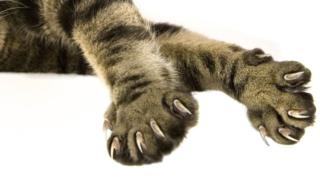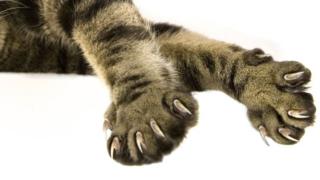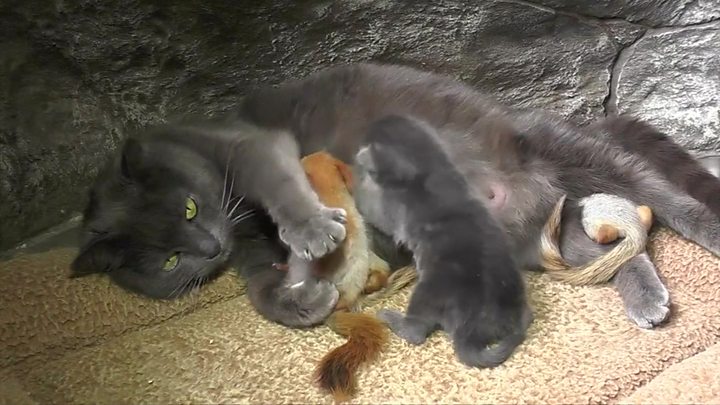Cat declawing: Should it be banned, and why does it happen in the US?

 Image copyright Getty Images
Image copyright Getty Images New York might become the first US state to ban cat declawing.
In a bipartisan move on Tuesday, lawmakers voted to make the procedure illegal, except where it is medically necessary for the cat.
The governor, Andrew Cuomo, needs to review and sign the bill before it becomes law.
Critics say cat declawing – which involves cutting off a segment of the bone attached to the claw – is “barbaric and inhumane”.
But the New York Veterinary Medical Society has argued that it should still be an option when otherwise the cat might be abandoned or put down.
Cat declawing is already illegal in many countries in Europe, including the UK, as well as Brazil, Israel, Australia and New Zealand.
Why is it so controversial – and why does it still happen in the US?
Why do people declaw their cats?
The most frequent type of declawing is called an onychectomy – it involves cutting the bones the claws grow from with a scalpel or laser.
Critics compare this to cutting off someone’s toes or fingers at their top joint, and say declawing can affect a cat’s balance.
There are some cases where the surgery is medically necessary, “if there’s a bad infection in the nail bed, or a tumour,” says Dr Sarah Endersby, veterinary development manager at International Cat Care, a charity.
However, she adds, many people declaw cats to stop them from scratching the furniture, which she calls “essentially an act of mutilation done to modify the cat for our benefit”.
Attitudes differ widely across the Atlantic. While many European countries signed a treaty forbidding the practice in the early 1990s, an AP poll in 2011 found that 55% of US cat owners said it was OK to declaw their cats.
Some studies suggest that between 20% and 25% of pet cats in the US have been declawed.
By contrast, “declawing was always rare” in the UK, even before it was outlawed in 2006, says Prof Danielle Gunn-Moore, a vet and chair of feline medicine at the University of Edinburgh.
“It was something we didn’t get taught at university. It became banned as more Americans came to the UK with declawed cats.”
Why do the UK and US have such different cat cultures?
“A big difference is that many more cats in the US are kept exclusively indoors,” says Dr Sarah Ellis, an expert in feline behaviour at International Cat Care.
Surveys suggest that only about 20% of pet cats in the UK live completely indoors, and that most owners in Europe also allow their cats outdoors. However, the proportion of indoor cats is thought to be much higher in the US.
It’s something that Judd Birdsall, a cat-lover and former US diplomat who now lives in the UK, noticed.
“When you go around a village in the UK you see lots of cats outside. I can’t ever remember seeing a cat outside in the US,” he told the BBC.
Experts believe Americans are more likely to keep cats indoors because many live in high-rise buildings in the city. Meanwhile, in rural places in the US, there are more likely to be predators such as coyotes and wolves.
Outdoor cats may find more suitable scratching material outside – like trees. It is also unsafe to declaw cats that go outside, as they may need their claws to protect themselves.
However, there is also a cultural difference, says Mr Birdsall.
“For Americans, it’s a matter of freedom and convenience – the right to the freedom to make decisions in terms of how you raise your cat, and convenience, because once you remove the claws, you don’t ever have to worry about you or the furniture getting scratched.”
“By contrast, in the UK, any concerns for freedom and convenience are vastly dwarfed by concern to the welfare of the cat – it’s unthinkable to declaw cats in Europe.”
Are indoor or outdoor cats better off?
- Indoor cats tend to have longer lifespans, because they are less likely to get hit by cars or encounter feline viruses.
- However, indoor cats need good environmental enrichment – otherwise they are much more likely to develop psychological problems
- Indoor cats in multiple-cat households are more likely to experience stress-related disorders if they don’t get on, because cats are naturally solitary animals
- Outdoor cats can express their inherent behaviour more readily, such as hunting and playing with bugs
- Vets say outdoor cats can appear braver, and more psychologically balanced, as they are challenged multiple times a day
- However in rural parts of the US outdoor cats are much more likely to encounter predators
Sources: Prof Gunn-Moore, Steve Dale, International Cat Care
Why is declawing so controversial?
Many experts say studies suggest that declawed cats are more likely to have health problems, such as back pain, or behavioural problems, such as aggression.
“Some studies suggest cats who have been declawed have a higher percentage of cortisol [the stress hormone], which is often associated with pain,” says Steve Dale, an animal behaviour consultant and pet journalist in Chicago.
Meanwhile, a study that scanned declawed cat paws found that “very few people actually do it properly – the procedure tends to leave bone fragments,” says Prof Gunn-Moore, adding that this could leave cats stepping on tiny fragments of bone when they walk.
Dr Endersby says that cats can continue to feel pain after the declawing procedure. “Part of its weight is borne on its toes – so after the declawing process their gait changes as they put their weight through their paws.”
However, Dr Drew Weigner, a vet in Atlanta who works on a foundation that funds feline medical research, cautions that “behavioural studies are notoriously difficult to accomplish successfully”.
Many vets, he argues, simply consider the procedure unethical now because it’s an unnecessary procedure.

Media playback is unsupported on your device
Are there situations where declawing should be permitted?
Many US veterinary societies are opposed to a ban because they say declawing should be allowed as a last resort, if the owner would otherwise decide to abandon their cat.
In the UK, Prof Gunn-Moore says she has only ever declawed two cats, when an elderly client was not allowed into her care home with her cats unless she could guarantee they would not scratch the furniture.
As the care home wouldn’t accept any other options, and as the cats were too shy to be re-homed, Prof Gunn-Moore contacted the Royal College of Veterinary Surgeons, who gave her permission to perform the procedure in this instance.
“I undertook the procedure on the grounds of stopping two cats from being euthanized, and the lady from losing her cats, but it sickened me the entire time”.
Declawing “has to be an absolute last resort”, she says, adding that most people declaw their cats for more frivolous reasons.
“A lot of people can’t be bothered to put the effort into training their cats – or don’t want a scratching post in their flat.
“Some people just like the way the paws look – I’ve had people tell me their feet look cuter and fluffier when declawed.”
Meanwhile, some vets have argued that declawing can be necessary when their owners have health issues that put them at risk.
One vet told the Denver Post back in 2013: “When my own husband was in chemotherapy and his immune system was compromised, I declawed my cat. I love her dearly, but I wasn’t going to take the chance that he might get an infection if she scratched him.”
However, the latest advice from the Centers for Disease Control does not recommend that patients declaw their cats – it simply advises that the cats are kept indoors, with “rough play” avoided.
Are things changing in the US?
They certainly seem to be. In addition to the proposed legislation in New York, individual cities such as Los Angeles and Denver have also banned declawing.
“Twenty years ago it was considered something you do – you get a cat, you declaw them,” says Dr Weigner. However, he argues that in recent years declawing has become “an increasingly controversial procedure… we stopped declawing cats at our practice a long time ago.”
Mr Dale says that, based on his personal experience, younger vets seem to be more supportive of a ban, especially as more recent research appears to provide evidence against declawing.
Mr Birdsall grew up in the US with pet cats that were declawed – but says that after living in the UK, he has discovered alternatives to declawing, such as trimming their claws. “Now I’m much more uncomfortable with the procedure, and don’t see the need for it”.
In the US, “things are generally trending in an anti-declawing direction… although it’s not a surprise that the one state moving towards banning the practice is a liberal blue state, and cities banning it are typically viewed as left-leaning,” he adds.
“Like many other issues, cat claws could become a politicised cultural issue in the US.”

Media playback is unsupported on your device
How can I train my cat not to scratch the furniture?
It’s normal for cats to scratch, as this is how they mark their territory with their scent and with claw marks, says Dr Ellis.
It also helps them keep their nails sharp, and stretches their back muscles.
However, she says owners can train cats to use scratching posts, although it needs to be at least as long as the cat’s length so it can stretch against it and drag its claws down.
Different cats have different preferences for the type of material, and whether the post is horizontal or vertical, she adds.
“We also need to think about location – cats need the posts at certain places, often prominent ones, because that’s where they mark their territory.”
Certain products include pheromones that attract cats, Prof Gunn-Moore adds, so she often uses that to train cats to use scratching posts.


